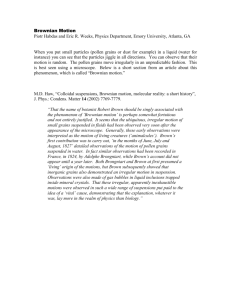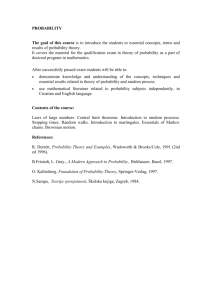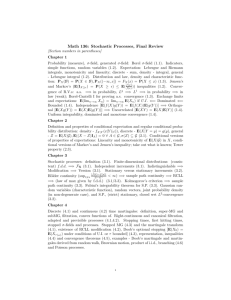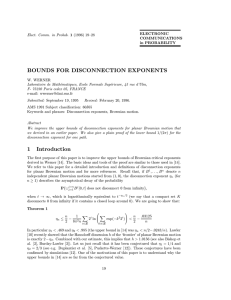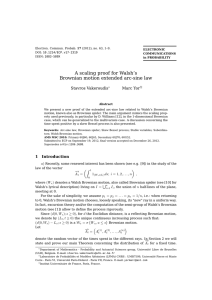The Zero Set and Arcsine Laws of Brownian Motion
advertisement
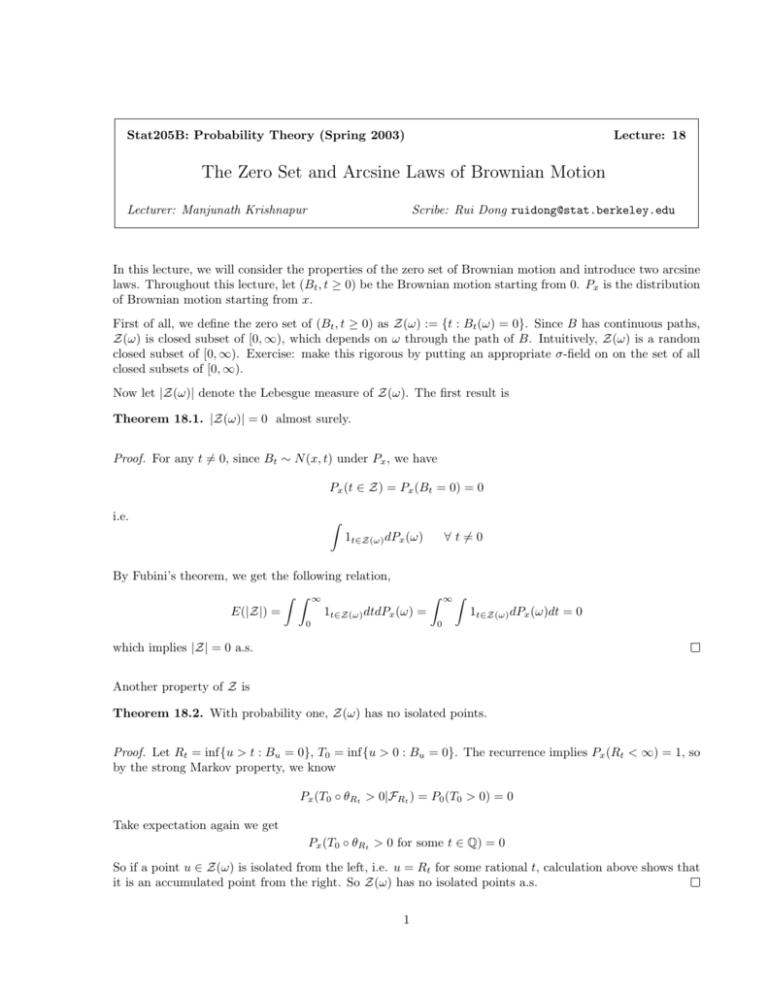
Stat205B: Probability Theory (Spring 2003)
Lecture: 18
The Zero Set and Arcsine Laws of Brownian Motion
Lecturer: Manjunath Krishnapur
Scribe: Rui Dong ruidong@stat.berkeley.edu
In this lecture, we will consider the properties of the zero set of Brownian motion and introduce two arcsine
laws. Throughout this lecture, let (Bt , t ≥ 0) be the Brownian motion starting from 0. Px is the distribution
of Brownian motion starting from x.
First of all, we define the zero set of (Bt , t ≥ 0) as Z(ω) := {t : Bt (ω) = 0}. Since B has continuous paths,
Z(ω) is closed subset of [0, ∞), which depends on ω through the path of B. Intuitively, Z(ω) is a random
closed subset of [0, ∞). Exercise: make this rigorous by putting an appropriate σ-field on on the set of all
closed subsets of [0, ∞).
Now let |Z(ω)| denote the Lebesgue measure of Z(ω). The first result is
Theorem 18.1. |Z(ω)| = 0 almost surely.
Proof. For any t 6= 0, since Bt ∼ N (x, t) under Px , we have
Px (t ∈ Z) = Px (Bt = 0) = 0
i.e.
Z
∀ t 6= 0
1t∈Z(ω) dPx (ω)
By Fubini’s theorem, we get the following relation,
Z Z ∞
Z
E(|Z|) =
1t∈Z(ω) dtdPx (ω) =
0
∞
Z
1t∈Z(ω) dPx (ω)dt = 0
0
which implies |Z| = 0 a.s.
Another property of Z is
Theorem 18.2. With probability one, Z(ω) has no isolated points.
Proof. Let Rt = inf{u > t : Bu = 0}, T0 = inf{u > 0 : Bu = 0}. The recurrence implies Px (Rt < ∞) = 1, so
by the strong Markov property, we know
Px (T0 ◦ θRt > 0|FRt ) = P0 (T0 > 0) = 0
Take expectation again we get
Px (T0 ◦ θRt > 0 for some t ∈ Q) = 0
So if a point u ∈ Z(ω) is isolated from the left, i.e. u = Rt for some rational t, calculation above shows that
it is an accumulated point from the right. So Z(ω) has no isolated points a.s.
1
2
The Zero Set and Arcsine Laws of Brownian Motion
Now we come to see the arcsine laws for Brownian motion. There are at least three different arcsine laws.
Here we will introduce two of them.
Let T = arg max0≤t≤1 Bt , notice T is well defined because all the local maximum of Brownian motion are
distinct. Our first arcsine law is
√
Theorem 18.3. For any t ∈ [0, 1], P0 (T ≤ t) = π2 arcsin( t).
Proof. For any t ∈ [0, 1], let Xr = Bt−r − Bt , Ys = Bt+s − Bt , then (Xr , 0 ≤ r ≤ t) is a Brownian motion
starting from 0 and is Ft measurable; (Ys , 0 ≤ s ≤ 1 − t) is also a Browian motion starting from 0 and is
independent of Ft . With this setup, we have
P0 (T ≤ t) = P0 (max Bu > max Bu )
[0,t]
[t,1]
= P0 (max(Bu − Bt ) > max(Bu − Bt ))
[0,t]
[t,1]
= P0 (max(Bt−r − Bt ) > max (Bt+s − Bt ))
[0,1−t]
[0,t]
= P0 (max Xr > max Ys )
[0,t]
[0,1−t]
d
d
By previous work, we know max[0,t] Xr = |Xt |, max[0,1−t] Ys = |Y1−t |, and they are independent. So if we
let Z1 , Z2 are i.i.d. ∼ N (0, 1), and θ is uniformly distributed on [0, 2π), then
P0 (T ≤ t) = P0 (|Xt | > |Y1−t |)
√
√
= P ( t|Z1 | > 1 − t|Z2 |)
|Z2 |
< t)
Z12 + Z22
√
= P (|sinθ| < t)
√
2
= arcsin( t)
π
= P(p
A little more calculation will show us the last zero point of Brownian motion on [0, 1] has the same distribution
as T above. Let L = sup{t ≤ 1 : Bt = 0}, and for a > 0, Ta = inf{t : Bt = a}, by previous work, for any
t > 0,
Z
P0 (Ta ≤ t) = 2P0 (Bt ≥ a) = 2
∞
(2πt)−1/2 exp(−x2 /2t)dx
a
Z
0
=2
(2πt)−1/2 exp(−a2 /2s)(−t1/2 a/2s3/2 )ds
t
Z t
=
(2πs3 )−1/2 a exp(−a2 /2s)ds
0
Use this formula, we have
Theorem 18.4. For any s ∈ [0, 1], P0 (L ≤ s) =
√
2
π arcsin( s).
The Zero Set and Arcsine Laws of Brownian Motion
Proof. By Markov property of Brownian motion,
Z ∞
P0 (L ≤ s) =
ps (0, x)Px (T0 > 1 − s)dx
−∞
Z ∞
=2
ps (0, x)P0 (Tx > 1 − s)dx
0
Z ∞
Z ∞
=2
(2πs)−1/2 exp(−x2 /2s)
(2πr3 )−1/2 x exp(−x2 /2r)drdx
0
1−s
Z
Z ∞
1 ∞
=
(sr3 )−1/2
x exp(−x2 (r + s)/2rs)dxdr
π 1−s
0
Z
1 ∞
(sr3 )−1/2 rs/(r + s)dr
=
π 1−s
Z
1 s
(t(1 − t))−1/2 dt
(let t = s/(r + s))
=
π 0
√
2
= arcsin( s)
π
R. Durrett. (1996). Probability: theory and examples.(2nd Edition) Duxbury Press.
3





